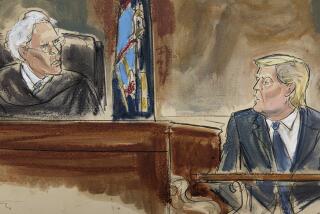Russian Money Trail Leading to More Banks : Scandal: U.S. is investigating international institutions’ reports of ‘suspicious activity’ that might be linked to possible laundering through a New York bank.
Deutsche Bank and other international financial institutions have reported to U.S. authorities on suspicious account activity that could be linked to possible money laundering by Russian organized crime figures through Bank of New York Co., sources said Monday.
Filing the reports to the Treasury Department’s Financial Crimes Enforcement Network suggests a widening of the federal inquiry into other so-called correspondent banks, which process transactions for other banks in foreign markets.
Investigators use the “suspicious activity reports” to track transfers between financial institutions. One such report, filed in August 1998 by Republic National Bank of New York, helped outline a money trail leading from an account related to Benex International Co.--which has ties to a firm controlled by a reputed Russian mobster--to Bank of New York, one of the nation’s oldest financial institutions.
Since early last year, more than $4.2 billion may have been channeled through the bank by organized crime and Russia’s political elite in order to keep it outside Russia’s fragile economy, according to sources close to the investigation.
The scandal has raised questions about the handling of aid money provided to Russia by the International Monetary Fund. The IMF said Monday that it may continue to keep new installments of a loan to Russia, a spokesman said. Since last year, the IMF has transferred no new money to the Russian central bank.
Rep. James A. Leach (R-Iowa), chairman of the House Banking Committee, has said that the IMF should cease lending until it can establish controls to prevent the money from being illegally diverted. Leach has scheduled hearings on the scandal for next month.
Confirmation of the new suspicious activity reports came as Bank of New York Chairman and Chief Executive Thomas Renyi told employees that the bank was examining its controls on transferred money.
“Our controls environment and practices are sound and effective,” Renyi said in an internal memo. “Nevertheless, we will take every opportunity to enhance them. Working with our staff and with our outside advisors, we are thoroughly examining our funds-transfer controls and processes.”
Bank of New York on Friday fired one of two executives it had suspended amid the fast-expanding investigation. Lucy Edwards, who oversaw Eastern European accounts for the bank in London, had been suspended Aug. 18. She is married to Russian businessman Peter Berlin, who records show is a director of Benex. She has not been charged with any wrongdoing.
A second suspended bank official, Natasha Kagalovsky, a senior vice president who oversaw the bank’s Eastern European business from New York, is married to Konstantin Kagalovsky, who until 1995 was Russia’s representative to the IMF. He also was deputy chairman of one Russian bank, Menatep, one of several large Russian banks that became insolvent last year.
The couple have denied any wrongdoing and issued a statement last week saying that they “have never been involved in money laundering in any way, shape or form.”
IMF officials said Monday that they have found no evidence that aid money was improperly diverted, either through the Bank of New York or other means. IMF aid to Russia has totaled about $16 billion since 1991.
But the case has emphasized the murky nature of international finance in the post-Soviet era. Money has been draining out of Russia at an alarming rate--some estimate $150 billion since 1991--as businesses and the political elite seek to protect their assets from economic collapse and Russia’s tax system.
Investigators now are trying to determine how much--if any--of the money flowing through the bank came from fraud related to Russian government contracts, commodities sales or securities.
But much of the capital flight from Russia is legal. Since Russian banks are notoriously unsafe, legal businesses find ways to convert their earnings to dollars, francs or deutsche marks and transfer them to banks in Switzerland, London or New York.
Still, U.S. officials have reported that Russia’s banks have contributed to the problem by assisting fraudulent schemes that allow profits to be concealed in offshore tax havens.
Investigators also have seen a rise in the use of forged securities by organized crime groups in financial transactions and in the emerging Russian stock market. One person allegedly linked to a similar scheme in the U.S. is Semyon Mogilevich, a reputed mobster who is believed to control YBM Magnex International, a Pennsylvania firm that pleaded guilty in June to securities fraud in U.S. District Court in Philadelphia.
Benex recently vouched for several Mogilevich associates who were seeking visas to enter the U.S., according to people familiar with the case. Russian authorities believed them to be mob associates and blocked the visas, the sources said.
The allegations surrounding Bank of New York are just one of a number of scandals swirling around Russia as political clans fight for influence in advance of December’s elections in that country.
In a separate scandal, President Boris Yeltsin, his family and associates are accused of accepting gifts from a Swiss construction firm that renovated Kremlin properties. The probe was started last spring by a Russian prosecutor who was subsequently forced out of office. The chief investigator in the case, Georgy Chuglazov, was taken off the case Friday and prevented from traveling to Switzerland this week to confer with investigators there.
“It is not a crime to have money in a bank account, even a foreign bank account,” Chuglazov told the Interfax news agency. “It’s another issue altogether, however, if we determine that the money came from illegal sources.”
Leeds reported from Los Angeles. Reynolds reported from Moscow. Times wire services were used in compiling this report.
More to Read
Start your day right
Sign up for Essential California for news, features and recommendations from the L.A. Times and beyond in your inbox six days a week.
You may occasionally receive promotional content from the Los Angeles Times.






